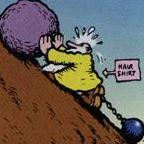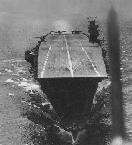Capitaine
Posts: 1043
Joined: 1/15/2002
Status: offline

|
quote:
ORIGINAL: DeadInThrench
Hmmm.... Joel.... If you open a forum here on Matrix on this project.... I am SURE you will get lots of comments. Yeah... maybe an unbelievable amount <g>.
Anyways... on the movement/combat sequence... I have been playing some TOAW recently and, it does movement/combat along these lines. What it does, when you make attacks, is take away movement points from all remaining units to stop unrealistic things from happenning. The problem with this, is you will have an attack on one part of the front affect what is going on in other parts of the front, or even other fronts if you have them. So, you end up having to micro-manage things across the entire front, and other fronts, on a round by round basis and this gets to be tedius and unrealistic as I see it.
So, what I suggested there (and they do not have the programming resource right now to deal with something like this), is you have an initial movement phase, where you do things like normal movement, moving in reinforcements, etc, as well as schedule all initial attacks... and then once you start resolving attacks, any additional movement points (assuming the unit would otherwise have them) would be based on PROXIMITY to an attack. In other words, if you had a 10 round turn, and an attack started on round 2 and ended on round 5, then all units, say, within 2 hexes of an attack, would have half their movement allowance left (assuming they would have it otherwise), to move and attack, attack again, etc.
With this, the computer would have to keep track of hexes that changed control as to what round they changed control, so that this system would not be abused (and units that moved into such hexes would have to pay the MP cost based on if they had waited for the hex to change control).
Also, in cases where a unit moved into a hex behind a defending unit, to keep it from retreating, the attack itself would in fact start AFTER that unit (and any other such units) moved into position.
And of course I am sure there would have to be many other considerations taken into account...
I was rereading this thread and I agree with the design that Joel described in the game being a combined movement/combat turn-based system in order to increase the enjoyment of the game. Yet DiT's comments are not lost on me either. You need to limit a system to prevent multiple attacks on defenders that defy time and space due to the "activity point" system in play. And I agree with DiT that TOAW's system is too flawed to be implemented in other games due to distortions among widely separated units.
The key, to me, isn't in adjusting the AP levels of the phasing player, but in assigning an "activity point" limit to defending units in the opposing player's turn as well. When a defending unit is attacked, the movement used by the phasing player's attacking units, plus a variable amount of APs due to combat, is expended by both the attacking and defending units. Combat results would be partially a function of the length of time spent engaged with the enemy. Once a defending unit's AP level is expended in the other player's turn, that unit may not be attacked again in that turn. And if there are only a few AP's remaining, any additional attack would have a less extensive result than an initial attack that could use as much time as needed for combat resolution.
So, with this approach, a defending unit that, say, retreats after combat would be using APs to do so which would limit the ability of other phasing units to attack it. This approach also doesn't need any "proximity" or "universal" deduction of APs from other units of the phasing player. It automatically differentiates between attacks that are made by units already in attack position at the beginning of the turn and attacks by units made after making large AP expenditures just to move into contact with the enemy.
This approach would likely require standard AP levels and increments for all units, but different rates of expenditure depending on movement class and terrain (e.g. an AFV would spend less APs to cross a hex than an infantry unit, even though they'd have the same number of APs).
Just a thought on how to solve the time/space issues raised in the quoted post. I'm really psyched about the new WiR game here and hope we'll get some more discussion by Joel and beta testers soon.
|
 Printable Version
Printable Version














 New Messages
New Messages No New Messages
No New Messages Hot Topic w/ New Messages
Hot Topic w/ New Messages Hot Topic w/o New Messages
Hot Topic w/o New Messages Locked w/ New Messages
Locked w/ New Messages Locked w/o New Messages
Locked w/o New Messages Post New Thread
Post New Thread